
The Appanoose County Courthouse is located in the county seat of Centerville, Iowa, United States. The courthouse was placed on the National Register of Historic Places in 1981. In 1997 it was included as a contributing property in the Courthouse Square Historic District.
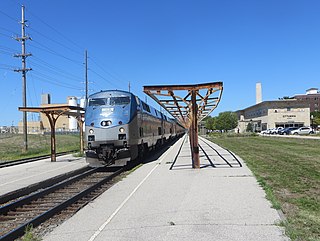
Ottumwa station is an Amtrak intercity train station in Ottumwa, Iowa, United States. The station was originally built by the Chicago, Burlington and Quincy Railroad, and has been listed as Burlington Depot by the National Register of Historic Places since November 26, 2008. It became a contributing property in the Historic Railroad District in 2011.

Osceola station is an Amtrak intercity train station in Osceola, Iowa, United States served by Amtrak. Osceola is the closest Amtrak station to Des Moines, Iowa's capital and most populous city, which is about 50 miles (80 km) to the north. The station is listed on the National Register of Historic Places as Chicago, Burlington and Quincy Depot.

Holdrege station is an Amtrak intercity train station in Holdrege, Nebraska, served by the California Zephyr. It was originally opened in February 1911 by the Chicago, Burlington and Quincy Railroad as the CB&Q Holdrege Depot, and the depot has been listed on the National Register of Historic Places since February 21, 1997. However, the depot is no longer part of the station facilities.

Grand Canyon Depot, also known as Grand Canyon Railroad Station, was constructed in 1909–10 for the Atchison, Topeka and Santa Fe Railway at the South Rim of the Grand Canyon, in what is now Grand Canyon National Park. It is one of three remaining railroad depots in the United States built with logs as the primary structural material. The station is within 330 feet (100 m) of the rim of the canyon, opposite the El Tovar Hotel, also built by the railroad. The depot is designated a National Historic Landmark, is listed the National Register of Historic Places, and is included in the Grand Canyon Village National Historic Landmark District.

The Atchison, Topeka and Santa Fe Passenger and Freight Complex is a nationally recognized historic district located in Fort Madison, Iowa, United States. It was listed on the National Register of Historic Places in 1992. At the time of its nomination it contained three resources, all of which are contributing buildings. The buildings were constructed over a 24-year time period, and reflect the styles that were popular when they were built. The facility currently houses a local history museum, and after renovations a portion of it was converted back to a passenger train depot for Amtrak, which opened on December 15, 2021.

The Burlington, Cedar Rapids and Northern Railway (BCR&N) was a railroad that operated in the United States from 1876 to 1903. It was formed to take over the operations of the bankrupt Burlington, Cedar Rapids and Minnesota Railway, which was, in turn, the result of merging several predecessor lines, the construction of which began in 1869. The corporate headquarters were in Cedar Rapids, Iowa, and it had operations in Iowa and in Minnesota. It was succeeded by the Chicago, Rock Island and Pacific Railway.
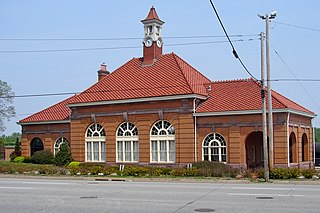
The Rock Island Lines Passenger Station, also known as Abbey Station, is an historic building located in Rock Island, Illinois, United States. It ceased operating as a railway station in 1980. The building was listed on the National Register of Historic Places in 1982, and it was designated a Rock Island landmark in 1987.

Wyoming was a Chicago, Burlington and Quincy Railroad station in Wyoming, Illinois. Now the headquarters of the Rock Island Trail State Park, the building is listed on the National Register of Historic Places as the Chicago, Burlington & Quincy Railroad Depot. The station has also been restored to the original red color.
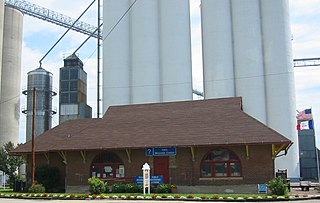
Burlington, Cedar Rapids & Northern Passenger Depot-Dows, also known as the Dows Rock Island Depot, is an historic building located in Dows, Iowa, United States. The depot was built in 1896 and served the Burlington, Cedar Rapids and Northern Railway as a combination passenger and freight station. The Romanesque Revival style was inspired by Henry Hobson Richardson's designs for small railroad stations. It was the first railway depot in Wright County. It passed to the Chicago, Rock Island and Pacific Railroad and continued to serve as a working depot until 1980. The Dows Historical Society bought and restored the depot in 1988. It now serves as a welcome center and railroad museum. It was listed on the National Register of Historic Places in 1993.

Wabash Combination Depot-Moravia, now known as the Wabash Depot Museum, is an historic train station located in Moravia, Iowa, United States. It is believed to be one of the two standard-plan wooden Wabash combination freight and passenger depots that remain in Iowa. Completed in 1903, it served the Wabash Railroad. The Queen Anne style building is an example of the rural combination station plan. The plan combined all railroad services from passengers to freight in one building. The museum features railroad artifacts, an operational model train layout and a restored railroad section car. The building was listed on the National Register of Historic Places in 1999 as a part of the Advent & Development of Railroads in Iowa MPS.

The Burlington, Cedar Rapids & Northern Freight House, also known as the Rock Island Freight House, is a historic building located in Burlington, Iowa, United States. It was listed on the National Register of Historic Places in 1983.

Keokuk Union Depot is an historic train station on the west bank of the Mississippi River near downtown Keokuk, Iowa, United States. It was built from 1890 to 1891, and it was listed on the National Register of Historic Places in 2013.

Creston station is an Amtrak intercity train station in Creston, Iowa. The station is served by the Chicago–San Francisco Bay Area California Zephyr. Constructed by the Chicago, Burlington and Quincy Railroad (CB&Q) and opened in 1899, the station is listed on the National Register of Historic Places as the Chicago, Burlington and Quincy Railroad-Creston Station. Amtrak moved to the historic station in 2019 from a small station immediately to its east that had been used since 1969. Creston station is also used by the city of Creston as a city hall and community center, known as the Creston Municipal Complex.

The Appanoose County Sheriff's House and Jail is a historic structure located in Centerville, Iowa, United States. Provisions for a jail in Appanoose County were not realized until 1855 when a small stone building was constructed. It was used for about ten years when one of the inmates easily escaped.

The former United States Post Office is a historic building located in Centerville, Iowa, United States. The Georgian Revival style structure was designed by the architectural section of the U.S. Treasury Department, which was under the supervision of James Knox Taylor at that time. Completed in 1904, the main block of the building is five bays wide, and three deep. It has quoined corners, and it is capped with a hipped roof with a wooden modillion cornice and a narrow, decorative frieze. The roof originally had a cupola in the center and a balustrade. An addition was built onto the west side of the building in 1932, and an enclosed loading dock was added in 1951. The post office moved into a new facility on North Tenth Street in 1977. The building was listed on the National Register of Historic Places in 1978. It was acquired in 1982 by the Appanoose County Historical Society for use as their museum.
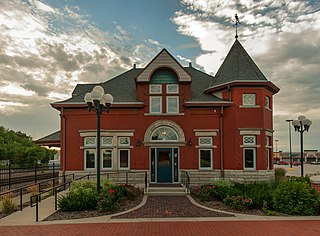
The Chicago & Northwestern Passenger Depot and Baggage Room-Carroll, also known as the Carroll Depot is a historic building located in Carroll, Iowa, United States. It is an example of a replacement station built along its Iowa mainline by the Chicago and North Western Railway (CNW) in 1896. It replaced a two-story, frame, combination station that was first built in 1867 by its predecessor line, the Cedar Rapids and Missouri River Railroad. That building had experienced two fires. The CNW had built two branch lines from Carroll in 1877 and 1880, which increased business and necessitated a larger depot. The Carroll Express Building was also built across the street for further railroad use. A separate wooden freight house had been built in 1888. Chicago architect Charles Sumner Frost designed this station in the Romanesque Revival style. The baggage room is separated from the depot by a breezeway. Frost designed at least 15 stations for the CNW in Iowa and Nebraska and another 14 in the Chicago area. The building represents the prosperity of the line during the Golden Age of Railroads.

The Chicago, Milwaukee & St. Paul Narrow Gauge Depot-LaMotte is a historic building formerly located in La Motte, Iowa, United States. The Chicago, Bellevue, Cascade & Western Railroad was incorporated in August 1877, to build a narrow-gauge railway from Bellevue to Cascade. Narrow-gauge was chosen because it was cheaper to build, and it could negotiate the tight turns on the rugged terrain better. Construction began the following year, but lack of money doomed the project. The Chicago, Clinton, Dubuque and Minnesota Railroad took over the project, and it was completed on December 30, 1879. The first train reached Cascade on January 1, 1880. Ten months later they sold all their holdings to the Chicago, Milwaukee & St. Paul Railroad, and this line became a branch line of the Milwaukee Road. That same year a frame depot was built in La Motte. It served as a combination freight and passenger station until it was destroyed by fire in 1910. This depot replaced it the following year. The 1½-story frame combination station represents the corporate style and standardized practices of the Milwaukee Road. However, it reflects the depots they built in the late 19th century, so it was somewhat outdated when it was built.
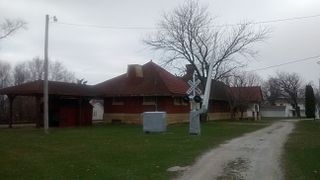
The Burlington, Cedar Rapids & Northern Passenger Station-Vinton, also known as Rock Island Depot and the Vinton Depot, is a historic building located in Vinton, Iowa, United States. Completed in 1900, this depot replaced a previous depot of the Burlington, Cedar Rapids and Northern Railway (BCR&N) located on the east side of town. It was designed by the railroad's architect and chief engineer, H.F. White, and built by A.H. Connor & Company of Cedar Rapids. The single-story brick structure was constructed on a limestone foundation. Three years after it was built, the BCR&N was acquired by the Chicago, Rock Island and Pacific Railroad. It continued to serve as a working depot until 1967. The Benton County Historical Society restored the depot and converted into a railroad museum. The building was listed on the National Register of Historic Places in 1990.

The Chicago, Rock Island and Pacific Passenger Depot-Pella, also known as the Pella Depot and the Rolscreen Museum, is a historic building located in Pella, Iowa, United States. The Des Moines Valley Railroad built the first tracks through the area in 1865, and they built a simple frame depot to serve passenger's needs. For 10 years, Pella served as the only rail stop in Marion County until a competing station was built in Knoxville, Iowa by the Chicago, Burlington, and Quincy Railroad. The Chicago, Rock Island & Pacific Railroad leased the Des Moines Valley's tracks beginning in 1878 and provided freight service through 1980. The old frame building was replaced, in 1906, with a single story, brick depot–a conventional building style for the railroad. The new, brick depot served as a passenger station until the latter 1940s. The last passenger service was as a stop on a short line motor train service between Eldon in southeast Iowa and Des Moines. The station was freight only by 1949.























